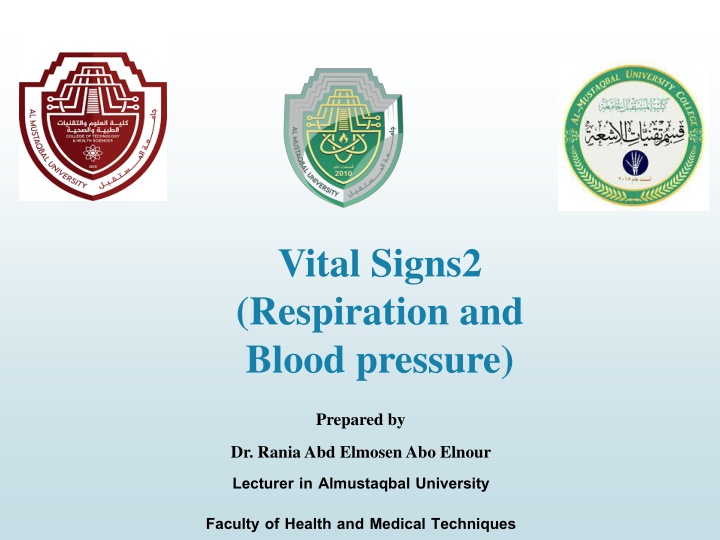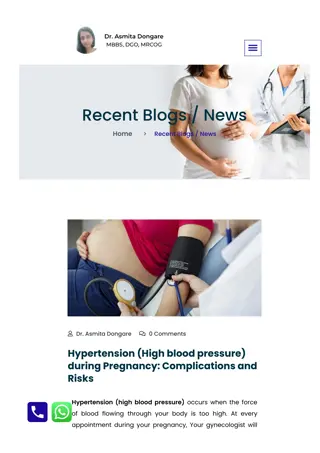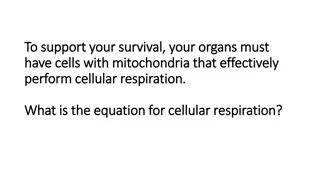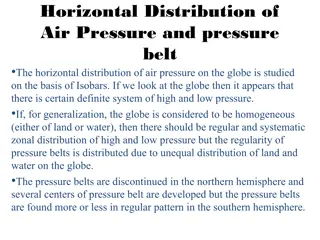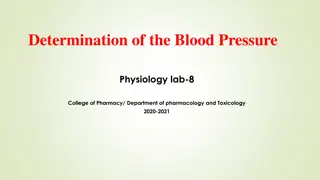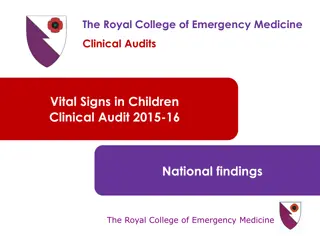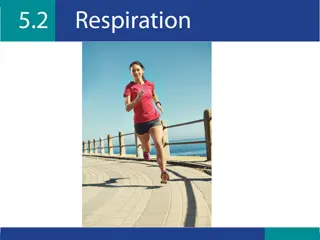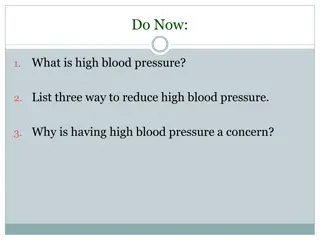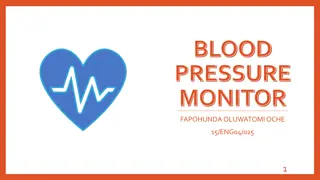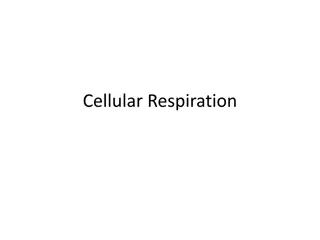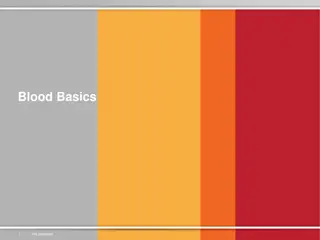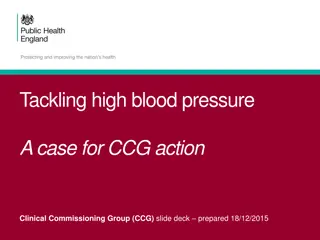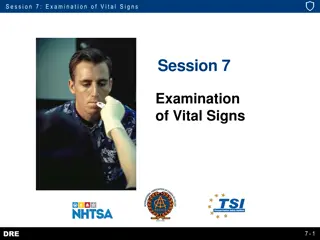Vital Signs: Respiration and Blood Pressure
Respiration, the act of breathing, is crucial for assessing a client's health. Factors influencing respiration, assessment methods, breathing patterns, secretion, and coughing are outlined in this informative guide. Learn about the procedures to check respiration accurately.
Download Presentation

Please find below an Image/Link to download the presentation.
The content on the website is provided AS IS for your information and personal use only. It may not be sold, licensed, or shared on other websites without obtaining consent from the author.If you encounter any issues during the download, it is possible that the publisher has removed the file from their server.
You are allowed to download the files provided on this website for personal or commercial use, subject to the condition that they are used lawfully. All files are the property of their respective owners.
The content on the website is provided AS IS for your information and personal use only. It may not be sold, licensed, or shared on other websites without obtaining consent from the author.
E N D
Presentation Transcript
Vital Signs2 (Respiration and Blood pressure) Prepared by Dr. Rania Abd ElmosenAbo Elnour Lecturer in Almustaqbal University Faculty of Health and Medical Techniques
Respiration Respiration is the act of breathing. Inhalation or inspiration refers to the intake of air into the lungs. Exhalation or expiration refers to breathing out or the movement of gases from the lungs to the atmosphere.
Before assessing a clients respirations, a nurse should be aware of the following: 1. Health problems on respirations. 2. Any medications or therapies that might affect respirations. 3. The relationship of the client s respirations to cardiovascular function. 4. Exercise affects respirations, increasing their rate and depth. 5. Anxiety.
Factors influencing of respiration : 1. Medication: increased or decreased 2.Acute pain: increased rate and depth of respiration. 3.Anxiety: increased rate and depth of respiration. 4. Smoking: increased rate and depth of respiration. 5.Anemia: increased rate and depth of respiration.
Assessment of Respiration 1- Rate: Normal: (14-20) breaths per minute 2- Rhythm; Regular Irregular 3- Depth; Deep -- normal Shallow--- abnormal
Breathing pattern Eupnea:- Breathing that is normal in rate and depth\ Normal: (14-20) breath per minute Bradypnea:- Abnormally slow respirations Tachypnea:- abnormally fast respirations Apnea :- is the absence of breathing. Dyspnea :- difficulty in breathing Orthopnea :- shortness of breathing when the patient lying flat (supine position)
Secretion and Coughing Haemoptysis: blood in sputum ( cough with blood) Productive cough: expectorated secretion. Non productive cough: dry cough.
Procedure to checking respiration: 1. Wash your hands. 2. Prepare all required equipment's (Watch). 3. Introduce your self and explain procedure to client. 4. Provide for client privacy. 5. Observe or palpate and count the respiratory rate by place the client s arm across the chest and observe the chest movements while supposedly taking the radial pulse. 6. Count the respiratory rate for 30 seconds if the respirations are regular. Count for 60 seconds if they are irregular. An inhalation and an exhalation count as one respiration. 7. Document the respiratory rate, depth, rhythm
Blood pressure Blood Pressure (BP): is a measure of the pressure exerted by the blood as it flows through the arteries. Blood pressure is measured in millimeters of mercury (mmHg) . Systolic Pressure is the pressure of the blood as a result of contraction of the ventricles, that is, the pressure of the height of the blood wave. Diastolic Pressure is the pressure when the ventricles are at rest
Hypertension: A blood pressure that is above normal. Hypotension: A blood pressure that is below normal. Orthostatic hypotension is a blood pressure that falls when the client sits or stands The systolic blood pressure of a newborn ranges between 50 and 80 mmHg; the diastolic between 25 and 55 mmHg
Factors Affecting Blood Pressure 1. Age. 2. Exercise 3. Stress. 4. Race. 5. Sex. 6. Medications. 7. Obesity. 8. Diurnal variations. 9. Medical conditions 10. Temperature.
Procedure to checking Blood pressure 1-Wash your hands. 2. Prepare all required equipment's (Stethoscope, Blood pressure cuff of the appropriate size, Sphygmomanometer). 3. Introduce your self and explain procedure to client. 4. Provide for client privacy. 5. Position the client appropriately. A. The adult client should be sitting. B. Both feet should be flat on the floor. C. The palm of the hand facing up and the arm supported at heart level. D. Expose the upper arm
. Cont.. 6. Wrap the deflated cuff evenly around the upper arm. Apply the center of the bladder directly over the artery. For an adult, place the lower border of the cuff approximately 2.5 cm (1 in.) above the antecubital space. 7. Palpate the brachial artery with the fingertips. 8. Close the valve on the bulb. 9. Position the stethoscope directly on the skin, not on clothing over the site. 10.Auscultate the client s blood pressure. 11.Remove the cuff from the client s arm
